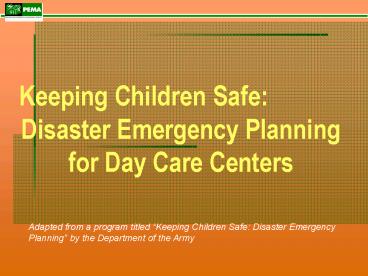Keeping Children Safe: PowerPoint PPT Presentation
1 / 19
Title: Keeping Children Safe:
1
Keeping Children Safe Disaster Emergency
Planning for Day Care Centers
Adapted from a program titled Keeping Children
Safe Disaster Emergency Planning by the
Department of the Army
2
Overview
- Why have emergency plans?
- What are the components of a plan?
- Who should be included in the plan?
- What resources are available?
- What are some lessons learned?
3
Why Have Emergency Plans?
- Natural disasters
- Terrorism now on U.S. soil
- Increases safety and security of children
- Peace of mind for children, parents and families
- Its required by State regulators
4
What are the steps to developing and maintaining
a Plan?
- Develop
- Monitor
- Implement
- Evaluate
5
Developing a Plan?
- Establish a planning team
- Assess the current situation
- Document existing capabilities
- Identify facilities, financial resources and
personnel needed - Develop transportation plans agreements
6
Developing a Plan? (cont.)
- Establish staffing and training
- Determine program needs
- Emergency information for children and staff
- Maintain quality licensing accreditation
- Practice the plan
- Monitor, implement (if necessary) and reevaluate
the plan
7
Implementing the Plan
- Make the plan official by having it signed by the
facility director/manager - Train the staff children on the provisions of
the plan
8
Monitoring the Plan
- Set schedule for periodic evaluation
- Consider situations that may affect your plan
- Make appropriate changes based on lessons learned
9
Evaluating the Plan
- What worked well? Was plan effective?
- What could have worked better?
- Were the community resources responsive?
- Were the parents satisfied?
- Did staff meet their responsibilities?
- What were the lessons learned by the experience?
10
Some Planning Hints
- Dont change the way you normally do things
- Plan for all-hazards
- Some protective actions will be applicable for
several hazards - Make everyone who will have a role aware of the
plan
11
What do we need to plan for?
- You must
- Decide on a protective action
- Implement the protective action
- Re-unite the children with their families
- Prepare to continue to run the day care facility
12
What do we need to plan for?
- 4 possible protective actions
- Immediate evacuation (fire or intruder)
- Immediate shelter (intruder or tornado)
- Shelter in place (HAZMAT or storms)
- Evacuate to host facility (flood or utility
outage)
13
The Plan should include
- Contact names phone numbers for
- All staff
- All parents
- Resource providers, esp. transport
- All host facilities
- Copies of written agreements for resources
- List of whos in charge, whos second, third,
etc.
14
What are somelessons learned from other
planning activities?
- Establish staff relief
- Ensure enough supplies and materials
- Keep family and staff records current
- Keep training current
- Keep ties to resources and referrals
15
lessons learned (cont.)
- Make arrangements in advance for food and water
- Coordinate with police for security
- Keep lists of resources current to help families
and staff - Establish plan to arrange for acceptance of
donations
16
lessons learned (cont.)
- Have immunizations and emergency records on-site
- Plan for emergency transportation
- Involve qualified mental health and other helping
professionals
17
Crisis Situations Some General Advice from
Experts
- Continually reassure the children that you will
keep them safe - Turn off the TV
- Be aware that each childs age will affect his or
her response - Calmly express your emotions
- Give the children extra time and attention
- Play with children who cant talk yet
18
Advice from Experts (cont.)
- Keep regular schedules for activities to restore
a sense of security and normalcy - Consider how you and your children can help.
Children are better able to regain their sense of
power and security f they feel that they can help
in some way.
19
What are some web resources?
- PEMA www.pema.state.pa.us
- FEMA - www.fema.gov
- Red Cross - www.americanredcross.org
- National Association for the Education of Young
Children - www.Naeyc.org - Pa Chapter, American Academy of Pediatrics -
www.paaap.org - National Association of School Psychologists
- www.nasponline.org

